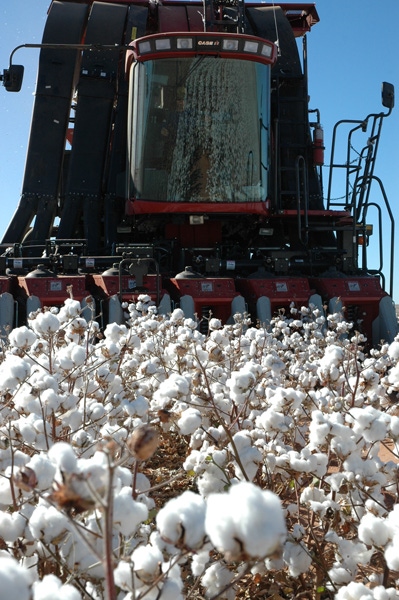
Growers, consultants and ginners throughout the Mid-South are expressing pleasant surprise at cotton yields. Their one regret: there aren’t more cotton acres.
“For the first time in several years, cotton harvest is good in Louisiana,” says John Kruse, LSU AgCenter cotton specialist. “We’re not done yet but are thankful that we’ve actually been able to bring in the crop.
“Right now, we’re around 60 percent harvested and yields are up. Some folks are saying it’s a really good year. Others say the crop is average – but they’re happy with ‘average’ because it’s been so long since they’ve been able to harvest an average crop. There’s been a bad taste in growers’ mouths after the last couple of harvests with the late rains and hurricanes.”
Arkansas’ cotton crop “is a lot better than we expected,” says Tom Barber, Extension cotton agronomist for the University of Arkansas Division of Agriculture. “I never dreamed it would be this good. I’ve heard good yields from the Bootheel all the way to the Louisiana border.”
Barber says the state’s cotton is around 35 percent picked. “A lot of the crop from central Arkansas to the southern border has been brought in. We’re picking up north, too, but there’s more cotton up there.
What about yields?
“The irrigated cotton yields, on the low end, are around two bales. On the high end, yields are at 1,500 to 1,600 pounds with a couple of fields that hit 1,900 pounds. I’ve heard of a couple of four-bale yields.”
Ginners
On Sept. 24, Peach Orchard Gin, in Gideon, Missouri, is running 24/7.
“Our irrigated cotton is really good – between two- and three-bale,” says Robbie Winston, gin manager. “Nobody is complaining about that, believe me.”
The area’s dryland crop, “unfortunately, is below average. We got no rain this summer and that hurt the dryland cotton. The good news, though, is the irrigated cotton is busting out. I’m hearing the same story all over the Bootheel.”
Such yields coupled with stellar market prices have farmers “saying they’ll grow a lot more cotton next year,” says Winston. “Cotton acreage will be back if the price maintains during the winter. That is music to my ears.”
Changing acreage picture
Buddy Cochran rues the loss of cotton acres to other crops in Mississippi’s Washington County. Still, Cochran – who runs Avon Gin in Avon, Miss. – says “the acres we have are really good. I’m hearing about a lot of two-bale-plus yields. One of my customers said he was crowding three bales.
“The other day, somebody asked me how I was doing. I said ‘I’m picking, ginning and grinning.’
Cochran says the county’s cotton acreage picture may change, “if the (current) price holds. As a matter of fact, I just had a farmer call wanting to know if he could gin with me next year. He said everybody and their brother will be planting cotton. He wanted to make sure he had a place to gin.”
Across the river in southeast Arkansas “we have a beautiful crop,” says Kevin Watts, ginner at McGehee Producers Gin, in McGehee, Ark. “Lots of folks are picking 1,500 pounds, or better. This is the best crop we’ve had in at least four years. This season was just ‘cotton weather’ – dry all summer and hot. This is probably the prettiest cotton I’ve ever ginned.
“One producer picked 1,787 pounds on 75 acres. He made 299 bales. That’s awesome.”
All this is good news for the gins, says Watts. “I thought we’d gin around 45,000 bales. At this point, though, it looks like we’ll hit 60,000 bales.
“We started ginning the earliest I ever have, on Sept. 2. Right now, we’ve done around 19,000 bales and are running wide open.”
Wayne Couch, ginner at Rhm Gin in Marked Tree, Ark., says the area’s crop “is good and ginning well. Yields are anywhere from 1,000/1,200 pounds to, I‘ve heard, 1,500 pounds. That’s great news because the acreage around here was down.”
With current prices, “next year could be big for cotton.” If farmers follow through on proposed acreage shifts “maybe we can look forward to a full yard and full warehouses in 2011.”
About the Author(s)
You May Also Like






